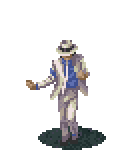Zombies, the red leather jacket, ghostly makeup, the legendary dance… With Thriller, Michael Jackson changed the music industry forever.
In 1983, the already popular Michael Jackson was getting ready to revolutionize the music world with Thriller. The global success surprised everyone — except the singer, who knew he had an ingenious idea when he transformed his song into a horrific short film. Vogue looks back at the story behind the video that made Michael Jackson an unrivaled icon.
A costly production
After seeing An American Werewolf in London in 1981, Michael Jackson contacted the director John Landis about the project for Thriller's music video. Unexcited, the label Epic Records was not thrilled about spending a large sum of money on filming a video (around 1 million dollars for 13 minutes), let them work alone. To afford the titanic cost, they sold a making-of show to a television channel. Michael Jackson, number 1 in sales thanks to his previous album Off The Wall and the already mounting success of Thriller, obtained the necessary funds to finance the short film, which he co-wrote with John Landis. A winning duo — Thriller is seen by many as the most legendary music video in history.
Filming locations
The video is divided into two parts: one scene parodying romance films from the 1950s with a young couple at the cinema; then, Michael Jackson and his girlfriend, played by Ola Ray, come face-to-face with the zombies invading the city. For the cinematic sequence inspired by the 1957 movie I Was a Teenage Werewolf, the production team headed to Palace Theater in the center of Los Angeles. Michael Jackson's fans gather on Union Pacific Avenue to recreate the zombie dance at the Thriller House on Caroll Avenue, where Ola Ray takes refuge to escape them.
An iconic costume
Deborah Nadoolman was in charge of costumes for the video, and most importantly those of Michael Jackson. The girlfriend of John Landis, she designed the outfits for Steven Spielberg's Raiders of the Lost Ark two years before. Now with cult status, the singer's outfit, composed of a leather jacket with shoulder pads and bright red pants, was chosen to contrast the dark decor and nocturnal sky. The garments were both flashy and casual, to allow Michael Jackson to perform his dance moves freely.
Frightening yet magnetic
When Michael Jackson approached John Landis to write and direct Thriller, he also hired his team. Having already collaborated with Rick Baker on An American Werewolf in London, John Landis turned to the makeup artist again for Thriller. In the making-of documentary, Rick Baker can be seen creating a face mold of the singer, to later create the famous werewolf head. The goal? Make Michael Jackson scary, but not ugly. The singer's face transforms into a dark creature, but we're still oddly fascinated. For the zombies' makeup, Rick Baker worked around the artist's face, accentuating the prominent bones (the cheekbones, the nose, the eye sockets…) and darkening the shadowy areas (dark circles, cheek hollows…). This gave a ravishing result, remaining loyal to the singer's features while making them more morbid.
Choreography to wake the dead
Having already worked with Michael Jackson on the hit Beat It, Michael Peters was hired to choreograph the Thriller dance. The zombies' legendary moves were created collaboratively by the choreographer and singer. Michael Jackson confessed that the greatest obstacle was bringing the living dead to life: “How can you make zombies and monsters dance without it looking comical? I teamed up with Michael Peters, and we imagined how zombies move around by grimacing in the mirror. I sometimes used to come to rehearsals in monster makeup, and I loved doing that.” Jazzy steps, a jerky walk, and abrupt movements mixed with the pro accuracy of Michael Jackson, his 18 professional dancers, and 4 pop-lock dancers… Thriller has surprised generations and continues to fascinate fans of modern dance.
His first female interaction
Before Thriller, Michael Jackson had shown very little, if any, interest in including women in his videos. For the first time, his character would feature alongside an actress. The role of his girlfriend was first offered to Jennifer Beals, the star of Flashdance, who declined. John Landis' eyes turned to Ola Ray, a wild-child friend of the singer, who would play the ‘frightened girlfriend’ role to perfection. To satisfy his female audience, Michael Jackson was urged to bring out his sensual side; he improvised provocative dance moves around his on-screen girlfriend. Rumors say that the on-screen chemistry between the co-stars played out in real life.
Why is Thriller such a legendary video?
On top of the media storm surrounding Thriller, still to this day the top-selling album of all time with 105 million copies sold, the video caused shockwaves in the music industry. Michael Jackson succeeded in proving to his critics that Black music had a place alongside white artists. Reluctant to air Beat It, the young channel MTV ended up acquiring the rights to Thriller, and attracted an audience 10 times larger than normal for its 2 December 1983 premiere. Also released on VHS, Thriller sold more than 9 million copies — a revolution for the era. More sophisticated, scripted, complex… Thriller transformed music videos into an industry of their own. In 1984, John Landis' short film won 3 awards from MTV: Viewer's Choice, Best Choreography, and Best Overall Performance in a Video. With even more prestige, the 1985 Grammy Awards gave the clip the Best Video award. Even today, Thriller is a reference point for video scripting and choreography, with more than 674 million views on YouTube alone.
Translated by Ella Jones

